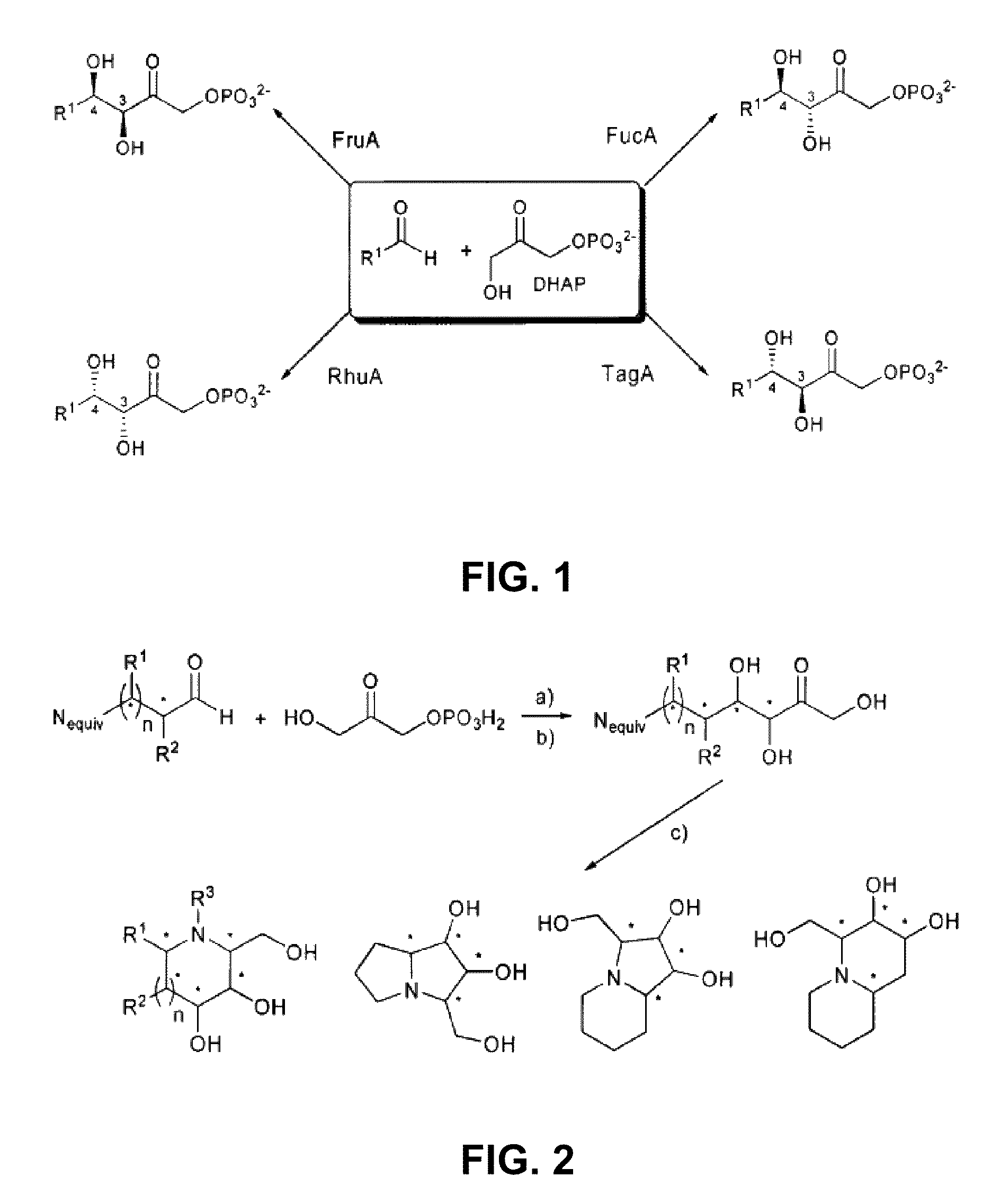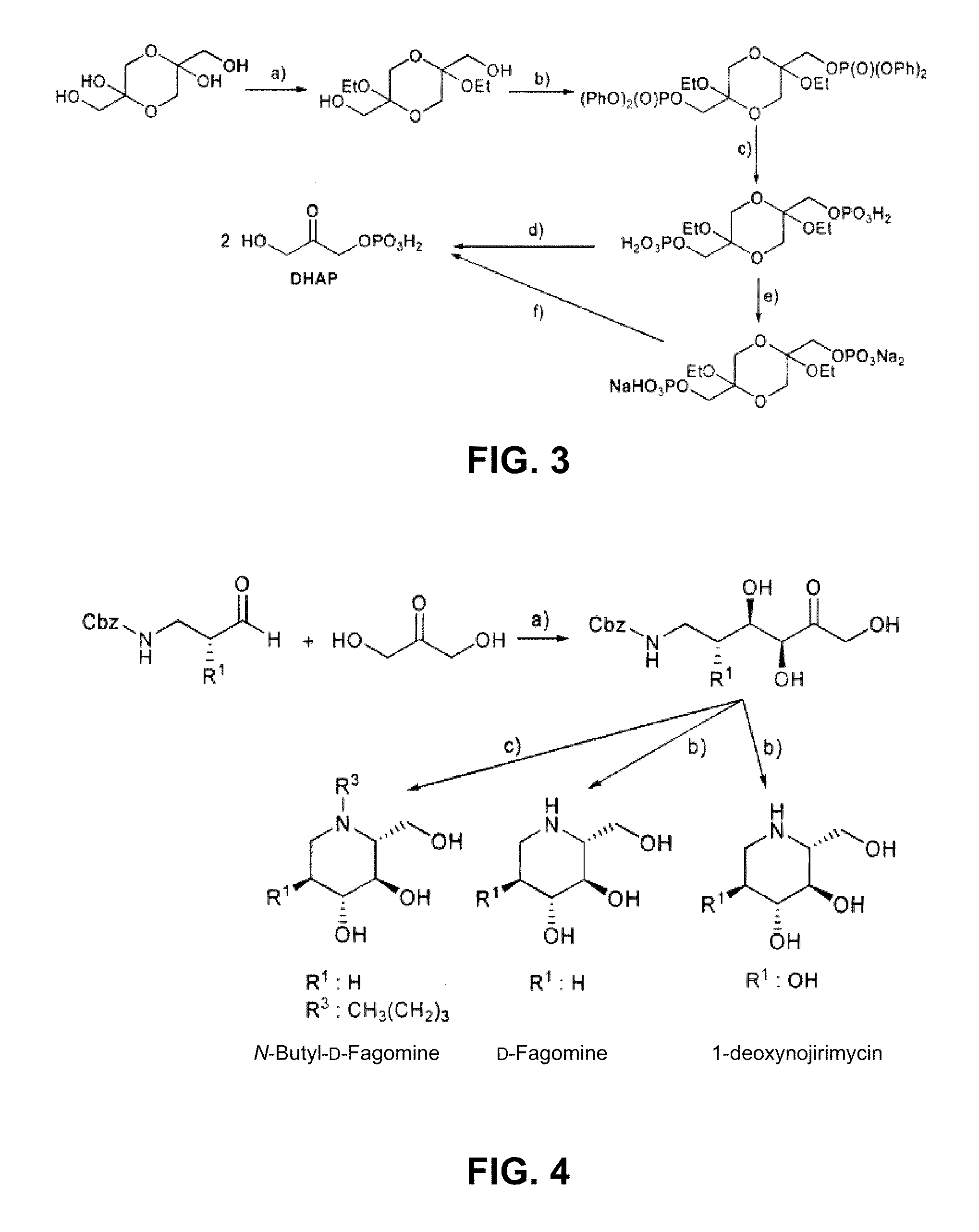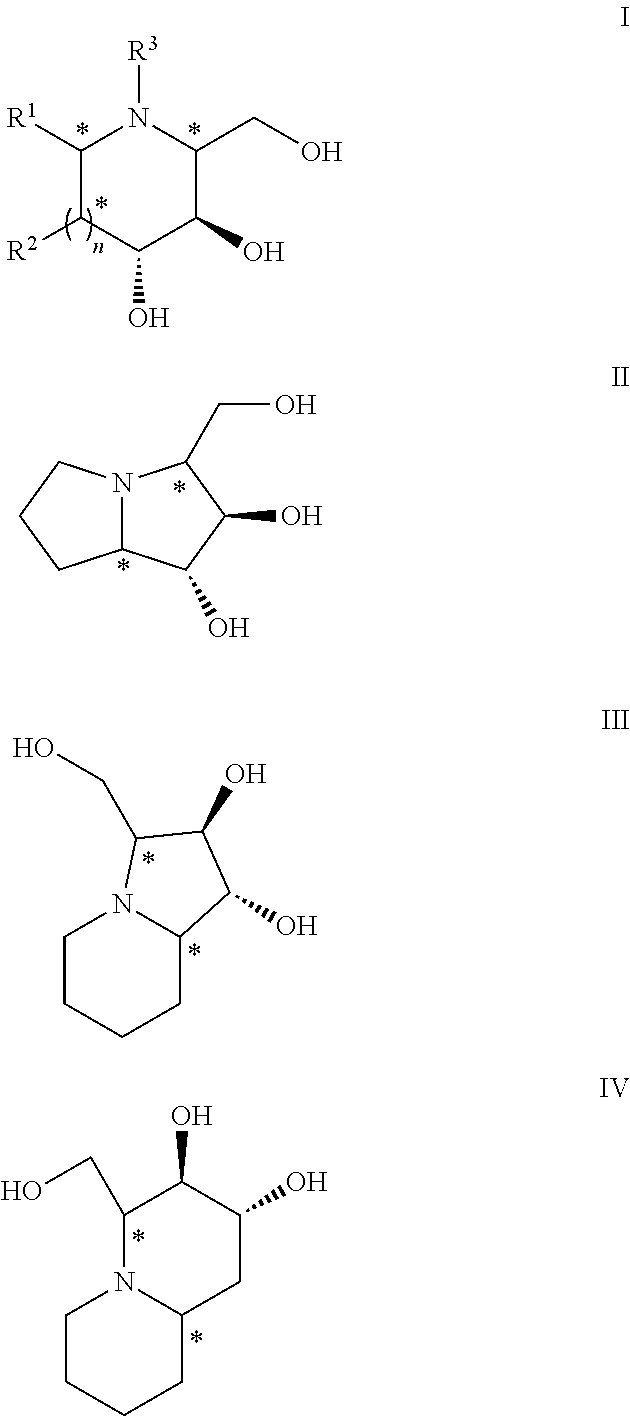Chemoenzymatic process for the preparation of iminocyclitols
a technology of iminocyclitol and cyclocyclitol, which is applied in the direction of enzymology, biochemistry apparatus and processes, lyases, etc., can solve the problems of limited industrial applicability, lot of steps, and inapplicability of arsenic salts
- Summary
- Abstract
- Description
- Claims
- Application Information
AI Technical Summary
Benefits of technology
Problems solved by technology
Method used
Image
Examples
example 1
D-Fagomine Synthesis
Step 1) Preparation of the Aldol Addition Adduct.
[0053]Starting aldehyde, N-Cbz-3-aminopropanal, was obtained from 3-aminopropanol by conventional processes disclosed by Espelt et al. (Espelt, L., Parella, T., Bujons, J., Solans, C., Joglar, J., Delgado, A., Clapés, P., Chem. -Eur. J. 9 (2003) 4887; Ocejo, M., Vicario, J. L., Badia, D., Carrillo, L., Reyes, E., Synlett (2005) 2110).
[0054]N-Cbz-3-aminopropanal (2.1 g, 22.9 mmol) was dissolved with dimethylformamide (40 mL) in a reactor of 250 mL of volume and equipped with orbital stirring. Dihydroxyacetone (4.7 g, 22.9 mmol) and FSA enzyme in raw powder (2.09 g, 3445 U) were added to this solution dissolved with boric borate buffer 50 mM pH 7 (155 mL). The mixture was left to react under orbital stirring (120 rpm) at 4° C. for 24 hours. The reaction conversion at this point was greater than 98%. Next, MeOH (200 mL) was added to the reaction mixture, appearing a precipitate which was separated by centrifugation. T...
example 2
N-Butyl-D-Fagomine Synthesis
Step 1) Preparation of the Aldol Addition Adduct as in the Previous Section.
Step 2) Deprotection and Double Reductive Amination.
[0058]The adduct resulting from the previous step (150 mg, 0.51 mmol) and butanal were dissolved in ethanol / water 7:3 (10 mL). Palladium over carbon (50 mg) was added to this solution and the mixture was left to react under H2 at 50 psi for 12 hours. Next, the process was similar to that of the previous example, and 52 mg of N-butyl-D-fagomine solid were obtained (yield 52%) after the purification of the reaction crude by a silica column using MeOH / CHCl3 mixtures as eluents.
[0059][α]D22=−24.5 (c 1.2 in MeOH); δH (500 MHz, D2O, 22° C.) 3.90 (1H, dd, J 12.7, and 2.4, 7-H), 3.82 (1H, dd, J 12.7 and 2.9, 7-H), 3.45 (1H, ddd, J 11.5, 9.1 and 5.1, 4-H), 3.30 (1H, t, J 9.4, 3-H), 2.90 (1H, td, J 12.2, 3.5 and 3.5, 6-H), 2.73 (1H, ddd, J 13.3, 11.2 y 5.4, 8-H), 2.50 (1H, ddd, J 13.3, 11.1 and 5.2, 8-H), 2.36 (1H, dt, J 12.6, 12.6 and 2.4...
example 3
1-deoxynojirimycin Synthesis
Step 1) Preparation of the Aldol Addition Adduct.
[0060]Starting aldehyde, (S)-N-Cbz-3-amino-2-hydroxypropanal, was obtained from (S)-3-amino-2-hydroxypropanol by a process disclosed by De Luca et al. (De Luca, L., Giacomelli, G., Porcheddu, A., Org. Lett. 3 (2001) 3041). The process was equivalent to that disclosed in Example 1, but in this case with the difference of performing the reaction at 25° C.
Step 2) Deprotection and Intramolecular Reductive Amination.
[0061]It was performed as in Example 1 obtaining 164 mg (yield 89%) of a white solid of 1-deoxynojirimycin. [α]D22+48.0 (C 1.0 at H2O). 1H NMR (500 MHz, D2O. δ ppm 3.74 (dd, J=11.8, 3.00 Hz, 1H), 3.56 (dd, J=11.9, 6.2 Hz, 1H), 3.4 (ddd, J=10.96, 9.06, 5.25 Hz, 1H), 3.24 (t, J=9.1, 9.1 Hz, 1H), 3.18 (t, J=9.4, 9.4 Hz, 1H), 3.1 (dd, J=12.3, 5.2 Hz, 1H), 2.54 (hept, J=9.4, 6.0, 3.0, 1H), 2.43 (dd, J=12.3, 11.0 Hz, 1H).
PUM
| Property | Measurement | Unit |
|---|---|---|
| pressure | aaaaa | aaaaa |
| volume | aaaaa | aaaaa |
| hydrophilic | aaaaa | aaaaa |
Abstract
Description
Claims
Application Information
 Login to View More
Login to View More - R&D
- Intellectual Property
- Life Sciences
- Materials
- Tech Scout
- Unparalleled Data Quality
- Higher Quality Content
- 60% Fewer Hallucinations
Browse by: Latest US Patents, China's latest patents, Technical Efficacy Thesaurus, Application Domain, Technology Topic, Popular Technical Reports.
© 2025 PatSnap. All rights reserved.Legal|Privacy policy|Modern Slavery Act Transparency Statement|Sitemap|About US| Contact US: help@patsnap.com



